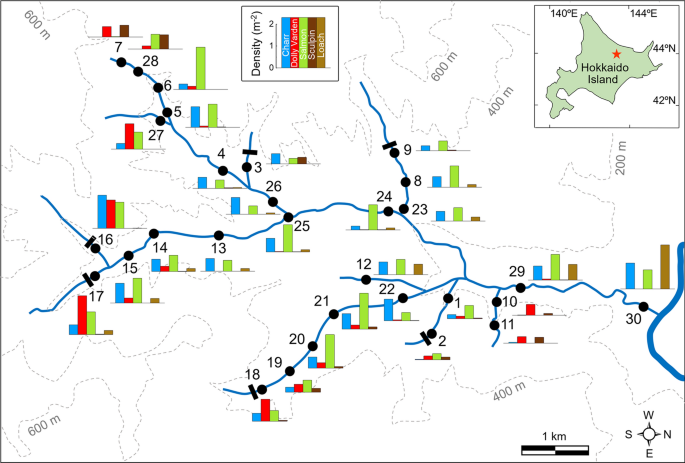Longitudinal structuring of stream-fish assemblages: is niche partitioning observed in two-species systems applicable to three-species systems?
IF 1
4区 生物学
Q4 FISHERIES
引用次数: 0
Abstract
Abstract Longitudinal distribution and niche partitioning phenomena have been extensively reported for streams containing two salmonid species but remain poorly understood for streams containing three or more salmonid species. Herein, we examined the abiotic environmental variables and population densities of fishes, including three salmonids, in 30 reaches of the Setose River, Hokkaido, Japan, across altitudes (120–450 m) and maximum water temperature (15–26 °C) gradients to determine the distribution of major fish species in this system. The densities of white-spotted charr Salvelinus leucomaenis , southern Asian Dolly Varden Salvelinus curilus , masu salmon Oncorhynchus masou , fluvial sculpin Cottus nozawae , and stone loach Barbatula oreas varied along environmental gradients despite their wide distribution sympatrically. We further investigated the interspecific interactions between three potentially competitive salmonids, white-spotted charr, Dolly Varden, and masu salmon. We observed that in the three-species system, including upstream Dolly Varden, salmon occupied upstream areas colder than those inhabited by charr, which is contrary to the pattern reported for charr and salmon two-species systems, wherein charr are found in the colder upstream areas. In underwater observations, salmon preferred faster water velocities than charr and Dolly Varden. Dolly Varden were found exclusively on the riverbed, followed by charr, whereas salmon occurred further away from the riverbed. Analysis of the stomach contents revealed that all three salmonids depended on terrestrial insects, but only Dolly Varden consumed benthic aquatic insects. In our three-species system that included Dolly Varden (preadapted to benthos foraging), no difference was observed in the degree of terrestrial insect consumption between charr and salmon. These results are in striking contrast to the reports of charr preying on relatively more aquatic insects than those consumed by salmon in charr and salmon two-species systems. Therefore, we speculate that Dolly Varden and salmon influence interspecific interactions between charr and salmon and between charr and Dolly Varden, respectively, explaining the distinct longitudinal distribution and feeding habits observed in two- vs. three-species systems. These variant interspecific interactions among the three competing species may have driven the expansion of their sympatric zones.

流鱼群落的纵向结构:在两种系统中观察到的生态位划分是否适用于三种系统?
纵向分布和生态位划分现象已被广泛报道了两种鲑科鱼类的河流,但对含有三种或更多鲑科鱼类的河流知之甚少。本文研究了日本北海道Setose河30个河段的非生物环境变量和鱼类种群密度,包括三种鲑科鱼类,跨越海拔(120-450 m)和最高水温(15-26°C)梯度,以确定该系统中主要鱼类的分布。白斑鲑Salvelinus leucomaenis、南亚Varden Salvelinus curilus、masu salmon Oncorhynchus masou、河流石鳅Cottus nozawae和石泥鳅Barbatula oreas分布广泛,但其密度随环境梯度而变化。我们进一步研究了三种潜在竞争鲑鱼,白斑鲑,多莉瓦尔登和马苏鲑鱼之间的种间相互作用。我们观察到,在包括上游多莉瓦尔登在内的三种系统中,鲑鱼占据的上游地区比鲑居住的地区更冷,这与鲑和鲑鱼两种系统中鲑居住在更冷的上游地区的模式相反。在水下观察中,鲑鱼比charr和Dolly Varden更喜欢更快的水流速度。多莉瓦尔登只在河床上被发现,其次是木炭,而鲑鱼则出现在远离河床的地方。对胃内容物的分析显示,这三种鲑鱼都以陆生昆虫为食,但只有多莉·瓦尔登以底栖水生昆虫为食。在我们的三个物种系统中,包括多莉瓦尔登(预适应底栖动物觅食),在陆地昆虫的消耗程度上,木炭和鲑鱼之间没有差异。这些结果与在鲑和鲑两种系统中鲑捕食的水生昆虫相对较多的报告形成鲜明对比。因此,我们推测Dolly Varden和鲑鱼分别影响了charr和鲑鱼之间以及charr和Dolly Varden之间的种间相互作用,这解释了在两种与三种系统中观察到的不同的纵向分布和摄食习性。这三个竞争物种之间的不同种间相互作用可能推动了它们同域带的扩展。
本文章由计算机程序翻译,如有差异,请以英文原文为准。
求助全文
约1分钟内获得全文
求助全文
来源期刊

Ichthyological Research
生物-动物学
CiteScore
2.80
自引率
16.70%
发文量
48
审稿时长
3 months
期刊介绍:
Ichthyological Research is an official journal of the Ichthyological Society of Japan and is published quarterly in January, April, July, and November. Ichthyological Research primarily publishes research papers on original work, either descriptive or experimental, that advances the understanding of the diversity of fishes. Ichthyological Research strives to cover all aspects of fish biology, including taxonomy, systematics, evolution, biogeography, ecology, ethology, genetics, morphology, and physiology.
 求助内容:
求助内容: 应助结果提醒方式:
应助结果提醒方式:


